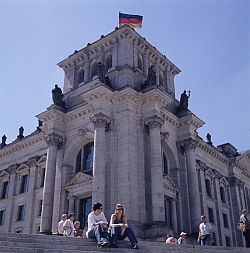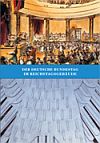Since 1990: An all-German parliament
First sittings in the Reichstag Building
The all-German Bundestag met for its first sitting in the Reichstag Building in Berlin on 4 October 1990, on the very first day after German unification.
It was made up of the Members of the German Bundestag elected in 1987 and 144 Members elected by the Volkskammer. The first all-German government was also formed immediately with the swearing in of five politicians from the former GDR as new federal ministers without portfolio.
The first joint elections were held on 2 December 1990. The governing coalition made up of the CDU/CSU and FDP continued in power under Federal Chancellor Helmut Kohl. Although the constituent sitting of the German Bundestag, which had grown to 662 members, was held in Berlin on 20 December, Parliament returned to Bonn for its further sittings.
East and West grow together
At the end of 1992, the German Bundestag began to hold its sittings in the new plenary chamber at Bonn. Even if there were few evident changes to parliamentary routines and procedures, the resumption of parliamentary work after unification did in some ways mark a new beginning.
For it was now necessary to cope with the challenge of integrating the two parts of Germany into a political, social, economic and cultural whole.
A great deal of time was spent on the financial implications of unification, which were the subject of controversial discussions. The work of building German unity required the mobilisation of massive monetary resources.
The preconditions for the funding of this task were put in place with the conclusion of a "solidarity pact of good sense" between the Federation and the Länder and the levying of a solidarity surcharge on income tax and corporation tax.
New responsibilities within the EU and NATO
With the agreement of the victorious Allied Powers, Germany gained full sovereignty over its internal and external affairs again, and the Bundestag voted for Germany to join the euro.
These developments gave Germany greater responsibility for the further development of the European Union (EU). The country became a driving force in the continuing process of European unification, both in the negotiations on economic and monetary union and in the conclusion of the Maastricht Treaty and the Treaty of Amsterdam, which provided for the deepening and structural consolidation of the EU.
The Bundestag also faced a new challenge when it had to decide whether German soldiers should take part in peacekeeping and peacemaking operations outside the NATO area. The Federal Constitutional Court ruled that such deployments were in conformity with the Basic Law. In 1995, the German Bundestag voted for the deployment of the Bundeswehr to Croatia and Bosnia.
Red-Green coalition takes power
In 1998, the electorate inflicted a clear defeat on Helmut Kohl and his coalition after 16 years in power. With Gerhard Schröder as its candidate for the chancellorship, the SPD emerged from the elections as the strongest party and was able to form a government together with Alliance 90/The Greens – known as the “Red-Green coalition” on account of the colours associated with the two parties.
For the first time in the history of the Federal Republic of Germany, the electorate had voted in a completely new government. Before then, at least one of the governing parties had always been involved in the previous coalition. And, for the first time since 1976, a Social Democrat became President of the German Bundestag again: Wolfgang Thierse.
The Party of Democratic Socialism (PDS) gained 36 mandates in 1998 and was able to enter the Bundestag with sufficient Members to form a parliamentary group for the first time. In accordance with parliamentary custom, it also received a seat in the Presidium.
From Bonn to Berlin
In 1991, the Members of the German Bundestag voted that Berlin should be the German capital and the seat of the country’s parliament and government.
In the same year, the Bundestag’s Council of Elders decided that the Reichstag Building should be restored and used for the work of Parliament. Following an international architectural competition, the British architect Sir Norman Foster was commissioned to renovate the building.
On 19 April 1999, the Reichstag Building, which had been dramatically remodelled inside, was opened with a ceremonial plenary sitting. About a month later, the Federal Convention assembled there and elected Johannes Rau as Germany’s new Federal President.
The Bundestag then moved from Bonn to Berlin during its summer recess. And on 7 September 1999, the 50th anniversary of its first sitting, the German Bundestag took up its work in Berlin.


